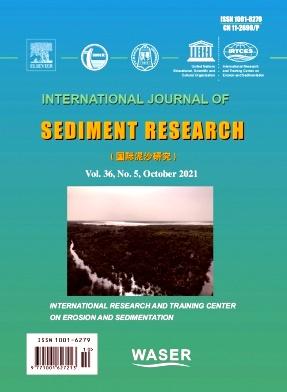Performance of microbially induced calcite precipitation (MICP) as a local scour countermeasure for offshore wind turbine monopile foundation
IF 3.7
2区 环境科学与生态学
Q2 ENVIRONMENTAL SCIENCES
引用次数: 0
Abstract
Microbially induced calcite precipitation (MICP) is an emerging method for mitigating scour and erosion. The present study experimentally investigates the efficacy of MICP as a local scour countermeasure for offshore wind turbine monopile foundations under both clear water and live-bed conditions. Bacteria were enriched using activated sludge. Analyses conducted included urease activity monitoring, unconfined compression testing, and examination using scanning electron microscopy. Various depths for the MICP protection elevation were tested in clear water conditions, and the resulting scour topography was mapped using photogrammetry techniques. Investigations were conducted on bedform migration and leading-edge scour upstream of the MICP protection, considering various protection elevations. The results indicated that MICP protection can provide effective scour protection under both clear water and live-bed conditions. Discussions in this study also extend to the erosion and potential collapse of the MICP protection structure. Flow undercut rate were also examined for evaluating potential failure of MICP protection structures, and the elevation of MICP protection has a significant influence on mitigating flow undercutting. Full protection efficiency was observed under clear water conditions when the MICP protection elevation was at the bed level and the flow intensity was relatively low (V/Vc = 0.65), while the highest average protection efficiency (47.73%) among all flow intensities was recorded when the MICP protection elevation was at 0.6D below the bed.
微生物诱导方解石沉淀(MICP)作为海上风力发电机组单桩基础局部冲刷对策的性能
微生物诱导方解石沉淀(MICP)是一种新兴的减轻冲刷和侵蚀的方法。本研究在清水和活床条件下,实验研究了MICP作为海上风力机单桩基础局部冲刷对策的效果。利用活性污泥富集细菌。分析包括脲酶活性监测、无侧限压缩试验和扫描电镜检查。在清水条件下测试了不同深度的MICP保护标高,并使用摄影测量技术绘制了冲刷地形图。考虑到不同的保护高度,对MICP保护上游的河床迁移和前缘冲刷进行了研究。结果表明,MICP保护层在清水和活床条件下均能提供有效的防冲保护。本研究还讨论了MICP保护结构的侵蚀和潜在崩溃。研究结果表明,MICP保护层的高程对减缓流动下切有显著影响。清水条件下,当MICP防护高程在床面水平且流动强度较低时(V/Vc = 0.65),防护效率最高,平均防护效率为47.73%,当MICP防护高程在床面以下0.6D时。
本文章由计算机程序翻译,如有差异,请以英文原文为准。
求助全文
约1分钟内获得全文
求助全文
来源期刊
CiteScore
6.90
自引率
5.60%
发文量
88
审稿时长
74 days
期刊介绍:
International Journal of Sediment Research, the Official Journal of The International Research and Training Center on Erosion and Sedimentation and The World Association for Sedimentation and Erosion Research, publishes scientific and technical papers on all aspects of erosion and sedimentation interpreted in its widest sense.
The subject matter is to include not only the mechanics of sediment transport and fluvial processes, but also what is related to geography, geomorphology, soil erosion, watershed management, sedimentology, environmental and ecological impacts of sedimentation, social and economical effects of sedimentation and its assessment, etc. Special attention is paid to engineering problems related to sedimentation and erosion.

 求助内容:
求助内容: 应助结果提醒方式:
应助结果提醒方式:


